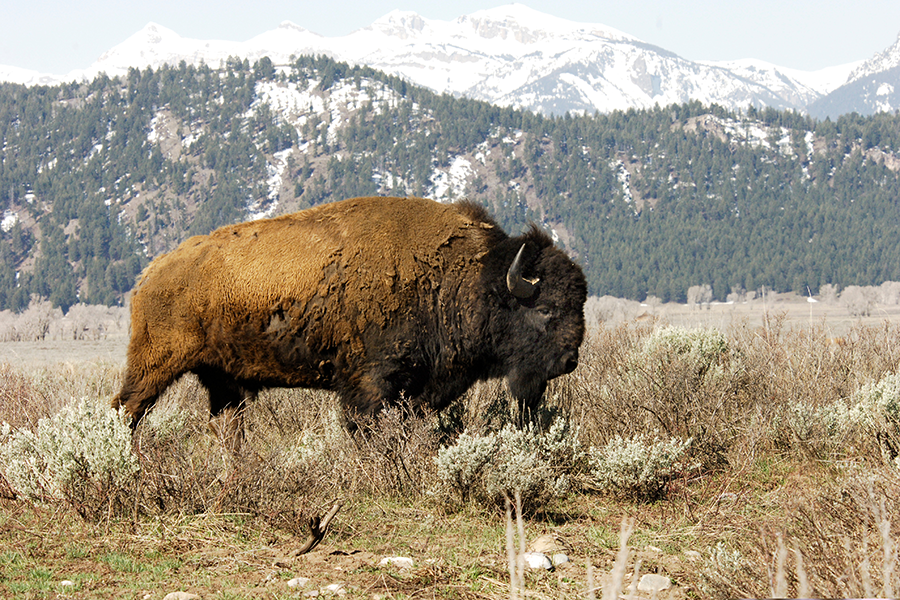Should North American bison be the US national mammal?
Loading...
The North American bison is a towering, shaggy beast that has roamed our continent for thousands of years. Many people have suggested that the largest American land mammal and icon of the country's cultural history and conservation deserves to be canonized as America's national symbol.
Their wish may soon come true.
The US House of Representatives voted Tuesday to adopt the North American bison as the national mammal of the United States. The Senate already voted in favor of the National Bison Legacy Act in December. Soon, the president will decide whether to bestow upon bison the honor of serving as the representative of quintessential American values.
"Its place in American history is unrivaled among species," says the Vote Bison Coalition, a group of rural communities, native American tribes, ranchers, wildlife conservationists, and other fans driving the the effort to elevate bison's national prominence.
"Bison today symbolize American values of unity, resilience and healthy landscapes and people," the coalition says on its website.
If the coalition's mission is successful, bison will join oak (designated as the national tree in 2004), the rose (national flower, 1986), and the bald eagle (national emblem, 1782) as official symbols of America.
"The bison will serve as a great national symbol for the United States as it is as strong as the oak, fearless as the bald eagle, and inspiring as a rose," said Cristián Samper, president and chief executive of the Wildlife Conservation Society (WCS), in a statement after the House vote this week.
WCS is a New Your City-based nonprofit that, along with the Intertribal Buffalo Council and National Bison Association, has led the movement to make bison a national symbol. An official designation, they say, would raise the animal's profile for the benefit of bison meat producers, conservationists, and native American tribes that lived in the Great Plains and revered the mammal as a sacred and spiritual symbol of their heritage.
Today there are approximately half a million bison in North America, most raised as livestock on ranches. Some live under conservation status in national parks and elsewhere, and others are on tribal lands and in zoos from Canada to Mexico. Fewer than 5 percent are wild.
But today's population represents less than 1 percent of the 30 to 60 million that are thought to have roamed North America before the mid-1800s, most of them across the Great Plains. Their grazing, trampling, and fertilizing supported the local ecosystems, writes John Calvelli, WCS's executive vice president of public affairs, in a National Geographic blog.
Bison were hunted nearly to extinction as Americans moved west. By the end of the 20th century, fewer than 1,000 survived. Theodore Roosevelt, a great conservationist who became president in 1901, launched efforts to restore their population across the plains. That effort is considered the first great conservation success story in American history, according to WCS.
It began with the shipping of 15 bison – each of which weighed as much as a ton – by train from the Bronx Zoo, created by WCS's founder in 1898, to Wichita Mountains Wildlife Refuge in Oklahoma in 1907.
"Many of the bison you see in the wild today can trace their roots back to New York," Mr. Calvelli told The Christian Science Monitor in an interview. "How New York City helped save the symbol of the West – just that story alone talks about how our country can work together," he said.
The Intertribal Buffalo Council, which represents almost 60 native American tribes, wants to reintroduce bison onto a million acres of Indian reservations to bring "jobs, a lean and healthy meat and traditional source of products for their families, and a return of their treasured cultural identity," according to the coalition. Bison were central to the lifestyle and culture of many western tribes before the tribes and herds were decimated by the arrival of white settlers.
"The buffalo allowed us to survive as a healthy people with a strong social structure and the return of buffalo into our daily lives can lead us on a path back to those times," wrote the council on its Facebook page Thursday.
Efforts to reintroduce bison are starting next month when 87 of the giant mammals from Elk Island National Park in Alberta, Canada – where they were shipped over a century ago by the US government – will be returned to Blackfeet Indian Reservation in Montana.
The American bison is recognized as the state mammal of Wyoming, Oklahoma, and Kansas. The Senate approved the House version of the bill late on Thursday night and sent it to President Obama. If he signs it into law, the US will join countries such as Finland and Mexico that each have a national mammal: brown bear and jaguar, respectively.
[Editor's Note: This story was updated to reflect news of the Senate's approval of the House version of the National Bison Legacy Act.]






